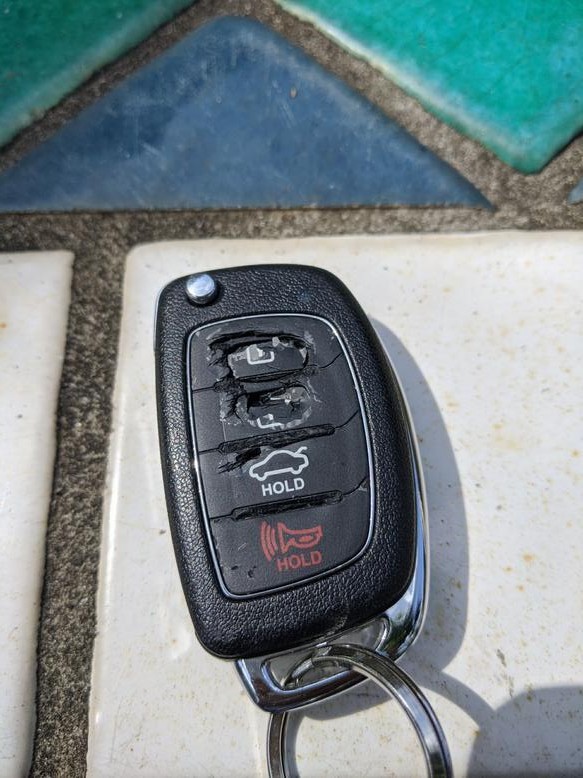Like many Hyundai Sonata owners, you might find yourself facing a frustrating issue: a key fob with buttons that have simply fallen apart. It’s not about wear and tear in the typical sense; it’s as if the plastic itself has decided to give up. If you’re experiencing this with your Sonata Key Fob, you’re not alone, and understanding your options is the first step towards a solution.
The problem started with my 2015 Sonata Sport. The key fob casing, specifically around the buttons, crumbled after years of use. The internal electronics and the key blade were perfectly fine, but the external buttons were a mess. Thinking I was smart, I grabbed a brand-new spare Sonata key fob that had never been used. To my surprise, within a day, it suffered the exact same fate – disintegration of the button casing. This wasn’t just wear; it was a material issue.
My research led me down the path of DIY repair videos, suggesting that swapping the internal components into a new key fob casing was a straightforward process. The promise of an easy fix and saving money led me to order a generic key fob replacement casing for around $20. When it arrived, the plan seemed simple enough: open both fobs and transfer the innards. However, reality quickly set in when I tried to open the original Sonata key fob. It was sealed, seemingly glued or fused together, leaving no option but to destroy the original casing to get inside. So, I proceeded, carefully breaking open the old fob.
This is where the real challenges began. Transferring the components to the new generic casing wasn’t the seamless process advertised. The parts just didn’t quite fit. They were close, maybe 90% there, but the subtle differences in casing design became major obstacles. The space for the circuit board in the new fob was slightly deeper and wider, causing the chip to move around. The original key blade was a fraction of a millimeter thicker, preventing the new casing from closing completely unless I was willing to file down the blade. These discrepancies, often mentioned in passing in online videos as minor modifications, were proving to be more significant.
Armed with a Dremel, I attempted to file down the key blade to fit the generic casing. It was then I discovered another issue: the pin that secures the blade was also slightly offset in the new fob. Frustration mounting, I abandoned the generic key fob experiment.
The seemingly obvious next step was to consider an OEM (Original Equipment Manufacturer) Sonata key fob casing. Thinking that spending around $40 on an OEM casing would solve the fitment issues, I ordered one. However, the OEM casing presented a different problem. Unlike the generic, split-in-half design, the OEM casing was also sealed and not designed to be easily opened for component transfer. Opening it would likely mean destroying it, just like the original.
This led to considering professional help. Taking the OEM casing to a locksmith became an option, but with the added cost of programming and key cutting, the price jumped to around $175. Contacting a Hyundai dealership for a complete Sonata key fob replacement quoted a minimum of $350.
At this point, a crucial question arises: Is there a simpler, more cost-effective solution to this common Sonata key fob casing disintegration issue? While generic casings might seem like a budget-friendly DIY fix, the fitment and modification challenges can be significant. OEM casings, while potentially better quality, might require professional programming and key cutting, substantially increasing the overall cost. Perhaps the best approach, despite the higher initial cost, is indeed to opt for an OEM key fob replacement handled by a locksmith or dealer, ensuring compatibility and proper functionality. Alternatively, the gamble of trying different generic casings from online marketplaces like Amazon or eBay remains, hoping to find one with a better fit, is a path some might consider, albeit with no guarantee of success.
